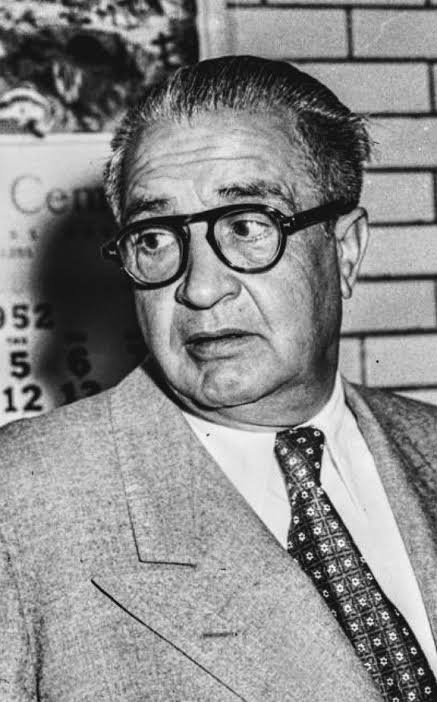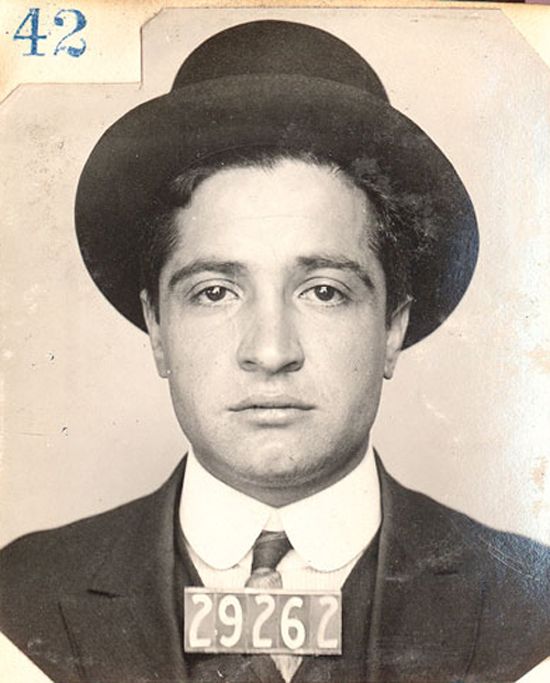Jack Dragna isn’t as flashy or well known as some mob bosses of his time, but he held the reins of the Los Angeles crime family firmly from the 1930s until he passed away in 1956. While names like Al Capone, Lucky Luciano, and Benjamin “Bugsy” Siegel grabbed all the attention, Dragna operated discreetly yet successfully running organized crime in Los Angeles. This made him a key player and a forceful figure among mobsters, on the West coast.
Early Life and Migration to the United States.
Jack Dragna, (formerly known as Ignazio Dragna) was born in Corleone, Sicily in 1891, a place with mafia ties. He probably learned about the criminal world during his youth there and adopted its principles and methods, which shaped his future role as a crime boss.
In 1914, Dragna moved to the United States. First lived in New York City before eventually relocating to Los Angeles. The decision to move to Los Angeles was deliberate as it offered promising prospects for advancement in the underworld. During that period, organized crime in California was relatively new compared to the established syndicates on the East coast, allowing Dragna to ascend rapidly within the hierarchy.
Rise to Power
In his days in Los Angeles, Dragna engaged in a range of unlawful pursuits such as bootlegging during Prohibition, extortion, and running gambling operations. His cunning and talent for forming alliances distinguished him from criminal figures in the region. Towards the end of the 1920s, Dragna had solidified his position as a figure in the Los Angeles underworld.
In 1931, after Joseph Ardizzone, the first boss of the Los Angeles mafia, passed away, Dragna became the leader of the Los Angeles crime family with the support of his colleagues in the West coast underworld and the Mafia Commission in New York City.
The Los Angeles Under Dragna
Under the guidance of Dragnas’s leadership, the Los Angeles crime family experienced a rise in strength and impact. Unlike his counterparts in New York and Chicago, Dragna showed disinterest in seeking public attention. His preference lay in keeping a modest presence while solidifying his influence covertly.
Dragna was famous for his leadership style; he valued steering clear of unnecessary confrontations and making sure his operations ran smoothly. He managed to stay on top of the Los Angeles underworld for more than twenty years despite facing challenges from rival gangs and law enforcement agencies.
Dragnas’s main tactic involved teaming up with criminal groups to safeguard his interests and expand his reach outside of Los Angeles to places like Las Vegas, where the mafia held sway.
Conflict with Benjamin “Bugsy” Siegel.
Despite Dragna’s approach as a leader, he encountered some challenges during his time in office. One notable difficulty arose with the arrival of Benjamin “Bugsy” Siegel in Los Angeles. Siegel, known for his ties to New York’s Mafia, was dispatched by the national Mafia Commission to manage the syndicate’s affairs in the growing Las Vegas casino scene.
Siegel’s entry into Los Angeles challenged Dragna’s dominance in the city’s underworld. The clash between the two individuals revolved around the territory and business dealings; Siegel’s bold strategies and flashy lifestyle contrasted Dragnas’s inclination towards maintaining a low profile. Although Dragna was displeased with Siegel’s approach, he had no choice but to accept his presence as Siegel had strong ties with mobsters from the East coast – notably Meyer Lansky.
The conflict between Dragna and Siegel reached its peak with Siegel’s murder in 1947. Although there is no proof connecting Dragna directly with the assassination, many historians speculate that he might have been involved in planning the hit, seeing it as a way of eliminating a major competitor and reestablishing control over his activities. That’s to go without saying Siegel was way over budget among other problems, but that’s for another story.
Downturns
In the 1950s, in Los Angeles, the local crime family started feeling the heat from law enforcement agencies on their back. The Kefauver Hearings; a set of Senate inquiries tackling organized crime, put the spotlight on mafia activities in Los Angeles under Dragna’s leadership. Although Dragna was able to stay under the radar compared to others in his circle, these hearings eventually spelled out doom for his rule.
In addition to the Sentate hearings, additional challenges arose within his organization as Dragnas’s hold over the Los Angeles crime family started to wane in his later years. A faction within his group grew dissatisfied with his tactics and hesitance towards aggressive expansion, striving for greater authority. This internal discord, along with escalating scrutiny from law enforcement, contributed to a decrease in the family’s influence.
Death and Legacy
In 1956, Jack Dragna suffered a heart attack and passed away. His death signaled the conclusion of a significant chapter for the Los Angeles crime family. His demise created a void in leadership that was never completely filled and eventually contributed to the decline of the crime syndicate he had established.

Even though he kept a profile and stayed out of the limelight, often associated with notorious mob bosses in Los Angeles during his time at the helm of organized crime for over two decades, Dragna contributed significantly to the underworld scene through his careful and discreet leadership style which ultimately solidified his enduring legacy as a key figure, in shaping the criminal landscape of the city.
Final Thoughts
Jack Dragna’s tale depicts a style of leadership that’s subtle yet impactful amidst a period marked by mob bosses craving notoriety and riches through brutality and media attention. Of seeking the limelight like his counterparts, Dragna opted to operate discreetly, navigating the complex realm of organized crime with precision. His sustained dominance over the underworld in Los Angeles stands as proof of his wit, prudence, and comprehension of the principles governing the mafia.
While Jack Dragna may not have garnered as much attention as other notorious figures in the realm of organized crime throughout history, his impact on the Mafia in Los Angeles remains undeniable, solidifying his place as a noteworthy character in the narrative of the American Mafia.

Mike,
This is one of the better articles I’ve seen covering the life of my great grandfather but there are some errors. As a crime historian and Jack Dragna’s biographer, I’ve been delving into his past for a quarter century now.
My family actually settled in East Harlem before the start of the 1900s. They were close with Giuseppe Morello’s family in New York, as they had been for a couple generations back in Corleone. They even lived in the same building on E 106th.
At nearly eighteen, Jack returned to Corleone with his family. After being conscripted and serving in the Italo-Turkish War he returned to New York, landing in March of 1914. Involvement in the murder of wealthy Jewish poultry man Barnett Baff seems to be what stirred him to head to Los Angeles and hide out on the Streva family ranch. He knew the family back in Sicily. They were already well established in the produce trade in San Pedro and were also involved in extortion. Jack dabbled in both very early on in Los Angeles.
Joe Ardizzone was actually the third boss of the Los Angeles Brugad, behind Rosario DeSimone and Vito Di Giorgio before him. Jack took control from Ardizzone, forcing him to step down, then he made him disappear shortly after.
Despite pop culture references and the tall tales of old mob books, Jack and Ben Siegel were actually business partners in the racing wire. Informant word and wiretapped telephone conversations found in the federal files show no sign of animosity or conflict. Quite the contrary, Jack was heard on multiple occasions praising Ben’s abilities as a partner. Each managed a subsidiary of a larger company that mafia families and syndicate members throughout the country owned a piece of. Ben had Las Vegas. Jack had Southern California.
The theory that Jack received some kind of ultimatum from Luciano or was subservient to Ben Siegel in his own territory goes against the very concept of the commission. It didn’t tell families how to run their territories. Each boss ran his family how he saw fit. The commission merely settled disputes between families.
Check out my pictorial Los Angeles Underworld. There’s a bio and photo of every known boss in LA.